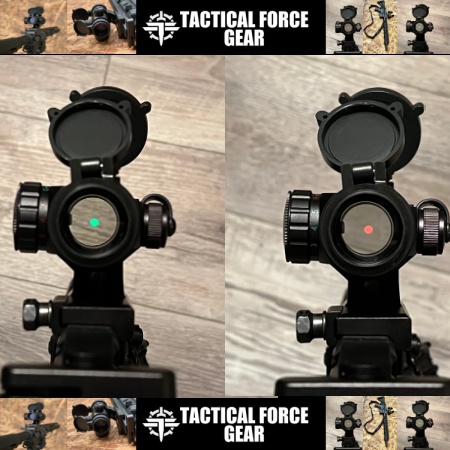We may earn revenue from the products available on this page and participate in affiliate programs. Learn More ›
The Staccato HD P4 is one of the more interesting and exciting pistols introduced so far in 2025, and it takes some big steps in redefining what we think of a 2011 pistol and making it a more reliable, versatile, and user-friendly handgun. The highlights are that this pistol uses Glock-pattern magazines, has a redesigned optic attachment system, and is fully ambidextrous. Our biggest question going into testing it was whether it would still feel and perform like the Staccato pistols we have gushed over in recent years. Spoiler alert, it was everything we’d hoped for and then some.
Staccato HD P4 Specs
See It
Pros
- Compatible with Glock’s proven magazine design
- Grip safety eliminated
- Excellent ergonomics and controls
- Very accurate
- Easy to shoot well
Cons
- Expensive
- Large for some concealed carry applications
- Caliber: 9mm
- Capacity: 18+1
- Action: Single-action, hammer-fired
- Barrel: 4-inch, bull profile, stainless steel
- Dimensions: inches 7.6 inches (L) x 5.5 inches (H) x 1.6 inches (W)
- Weight: 35 ounces (with empty 18-round magazine and no optic) (measured)
- Frame: 4140 Steel
- Slide: Steel
- Optics: Cut for optic, HOST mounting system
- Controls: Ambidextrous
- Finish: Black
- Grip: Polymer grip module, fine stipple texture
- Sights: Tall iron sights, rear sight forward of the optic cut
- Trigger: Curved shoe, 2 pounds, 10 ounces (measured)
- MSRP: $2,499
Key Features
- Uses Glock G17/G47-pattern magazines
- Grip safety eliminated
- Ambidextrous slide stop and reversible mag catch
- New Host optic mounting system
- Grippy stipple texturing
- Aggressive front and rear slide serrations
- Flat-spring recoil system
A New Take on the 2011

We’ve covered other 2011 pistols from Staccato like the Staccato P and Staccato CS, as well as 2011 style pistols like Springfield’s Prodigy and the MAC 9 DS, but the new HD line from Staccato, which includes the P4 and P4.5, ushers in some big changes that make the pistols quite different from the popular STI 2011s of years past. What does this mean for the end user, and are they even 2011s still?

What is a 2011 Anyway?
Before we decide whether to cry foul about some of the changes these new 2011s embrace, we need to define what we’re talking about. Staccato has trademarked the term “2011” for its pistols so, technically, they are the only 2011s. What most people refer to as 2011s, or 2011-style pistols share a few traits.
The 2011 family and 2011-style pistols are all double-stack 1911s, most commonly chambered in 9mm. They are single-action, hammer-fired pistols, just like the classic 1911-A1. The most defining characteristic of the genre is a short frame that terminates at the top of the grip, where traditional 1911 pistols have a frame that encompasses the whole grip. A polymer or metal grip module is attached to the frame, and they are separate pieces entirely.
The Staccato HD P4 Embraces Glock Mags
The most radical change that the Staccato HD P4 displays is compatibility with Glock-pattern magazines — specifically the full-size 9mm 17-round variants. This is a big departure for the 2011, which has relied on double-stack magazines that bottleneck to single stack. An issue that hasn’t helped the 2011 is that these magazines are expensive and can be finicky. The move to adopt a common, affordable magazine pattern with a complex, premium gun isn’t a new concept. We’ve seen many rifle platforms designed to use AR-style magazines, and PCCs built to run on Glock mags too. A couple short years ago, OA Defense launched the 2311, which follows similar design concepts as the 2011, built around the common Sig P320-pattern magazine.
The Staccato HD P4 is compatible with polymer Glock magazines, but ships with Mec-Gar 18-round steel Glock pattern mags. Going into testing, we were eager to see how this might change the feel or function of the 2011, if at all. We tested it at our annual gun test at Gunsite Academy, where we were anything but disappointed. Whatever ergonomic tweaks may have been necessary to accommodate this different magazine design, we didn’t notice them. The pistol ran like greased lightning, and the test team was all smiles.

Staccato HD P4 New HOST Optic System
Second to the magazines, the most significant update the P4 has is an all-new optic mounting system. Previous 2011s used Dawson Precision optic plates to accommodate different footprints. The plates included a tall rear sight that is able to cowitness through many red dots.
The cut on the new HOST system seems to allow the optic to sit even lower. Rather than a plate screwed to the slide with the optic attached to it, HOST uses thin spacers to adapt to different footprints, and longer optic screws so that the red dot fastens directly to the slide. This eliminates an extra set of fasteners that can rattle loose.
This pistol is also designed to run with a red dot. It includes iron sights, but the rear sight is located forward of the optic cut, just behind the ejection port, and allows co-witnessing through the glass. Even with the chunky Aimpoint ACRO, the dot was a snap to acquire and close enough to the bore axis to easily maintain sight picture through the recoil cycle while we shot it.
No More Grip Safety
One of the classic features of the 1911, the grip safety, has been cut from the lineup on this modern 2011. Frankly, this change is overdue. Some shooters love the grip safety, to others it’s been an annoyance for decades. Eliminating the grip safety changes the look of the pistol slightly, but it doesn’t seem to change the grip angle or pointing characteristics compared to previous models like the Staccato C, CS, and P.

The pistol still has an excellent, well-fit thumb safety with ambidextrous levers. It’s easy to manipulate while remaining tight, and provides a solid resting surface for the strong hand’s thumb while shooting. Additionally, Staccato has installed a slide stop lever on the right side of the pistol, and a reversible mag catch button too. The slide stop lever is great for lefties, but some shooters might prefer to actuate it with their trigger finger during reloads, rather than use their support-hand thumb — the slide stop is too far for most shooters to reach with the strong hand without breaking grip.
Internals
Most of the Staccato HD P4 is similar to what you’ll see on earlier models and other 2011-style pistols. It has a stainless bull barrel and no barrel bushing. A punch or pointed object is handy for takedown as you’ve got to press the takedown pin through the notch in the starboard-side slide stop lever. The barrel — as on the CS — has machined grooves and a flat bottom which reduce weight and bearing surface with the slide and other parts. Compared to the Staccato P and CS, the P4 uses a simplified recoil system, with a single guide rod and flat recoil spring.

The Staccato HD P4 on the Range
When circulating in a mixed bag of pistols, the Staccato HD P4 stood out to every member of our test team. At each gun test, there are always a few guns that shooters — including me — just can’t keep their mitts off of. We kept this pistol warm for the better part of a week. Its ergonomics and shootability are superb, which we expect from Staccato.
The pistol points naturally, has a great trigger, and nearly drove itself once I got the red dot centered on the teardrop-shaped steel targets in that dusty square range. The more elegant recoil system oscillates smoothly, brass ejects with robot-like consistency, and magazines glide effortlessly out of and back into the polymer grip module.

Accuracy
The P4 delivered very good accuracy during our evaluation. Shooting off a bag on a tripod at 15 yards with Staccato’s 136-grain Match ammo, it printed 5-shot groups that averaged 1.09 inches. By way of comparison, Shooting Editor John B. Snow performed this accuracy drill with the same lot of ammo out of his Staccato CS and its five-shot average was also exactly 1.09 inches, indicating that this new pistol upholds Staccato’s reputation for precision.
The P4’s accuracy while braced on a sandbag is one thing, but it was equally pleasing to see how attainable more practical accuracy was. Even at 50 yards, the pistol was a dead ringer on the small vital-sized steel targets and a sloppy or hasty trigger pull was the only thing to blame for misses.

Final Thoughts
It can be tempting to fawn over flashy, expensive guns, but it requires us to be more scrupulous, picky, and maintain higher expectations. One thing we appreciate about the Staccato HD P4 is that it truly brings the value, versatility, and performance required of its price tag. Though we questioned how some of the changes and updates might help or hurt the platform, it’s pretty hard to find anything to complain about. It’s well worth the money which, by the way, is about the same as their previous models.
Read the full article here




